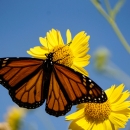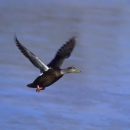Seasons of Wildlife
January & February
Although these months are typically cold and blustery, our nesting bald eagles spend their time laying and incubating eggs. The eagles are often seen hunting over the refuge’s pools where you're likely to find a wide variety of wintering waterfowl. Meanwhile, the forests provide cover for mammals and songbirds such as eastern towhees and yellow-rumped warblers.
March
As our bald eagle hatchlings emerge from their shells, the migratory waterfowl begin to depart for their northern breeding grounds. Shorebirds also arrive and begin courting for their nesting season. On March 15, the southern end of the island (known as the “Hook") is closed to all public use to protect habitat for the threatened piping plover and other beach nesting birds.
April & May
A diversity of migratory shorebirds and songbirds arrive on the refuge.
June
his marks the beginning of the high tourist season as people migrate to the seashore for family vacations. Ticks and tick-borne diseases require visitors to check for unwanted “hitchhikers” after exploring the refuge’s many hiking and biking trails. The first week of June is National Fishing Week.
July
Many visitors flock to the refuge on the last consecutive Wednesday and Thursday of July for the annual pony penning activities conducted by the Chincoteague Volunteer Fire Company in the town next to our refuge. Many species of wading birds, gulls, terns, and songbirds can be found throughout the refuge.
August
Mole crabs, ghost crabs and coquina clams frequent the seashore and herons and egrets line the ditches along Beach Road. Southward shorebird migration begins.
September & October
From mid-September to mid-October a number of hawks and falcons migrate through Assateague Island. The first migratory waterfowl arrive in September; however, the peak waterfowl migration usually occurs in November and December.
November & December
These are splendid months to observe a variety of waterfowl, including snow geese. Chincoteague Refuge boasts thousands of snow geese who overwinter or use the area for feeding and resting as they migrate further south. Additionally, visitors can tour the northern portion of the refuge during Thanksgiving as part of the annual Waterfowl Weekend Celebration.
Featured Species
We have a diversity of habitats, ranging from the beach and dunes to the vast salt marshes to the west of the islands. It's no surprise then that our wildlife is equally varied and bountiful, from the Delmarva Peninsula fox squirrel, an animal recently removed from the endangered species list, to our vast array of migratory and nesting birds such as the threatened piping plover. This refuge is truly a wildlife enthusiast's paradise.






